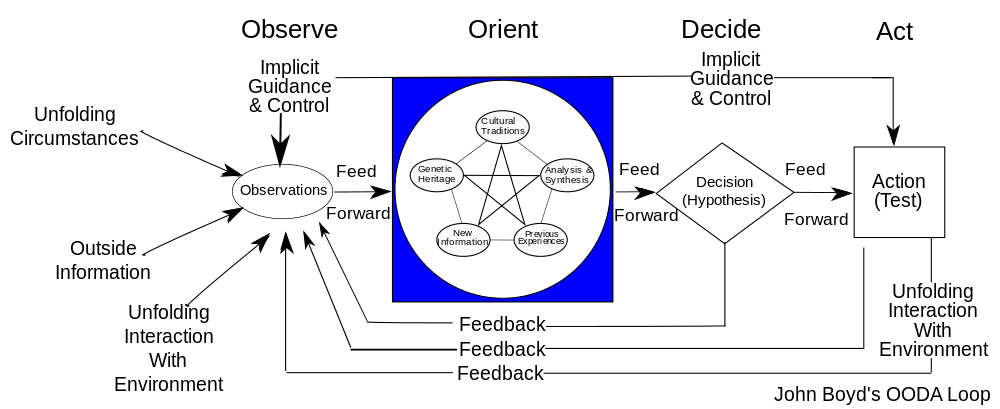Situational Awareness – Where does it begin? Where does it end?
Blog: Form Follows Function

Situational awareness, according to Wikipedia, is defined as “…the perception of environmental elements and events with respect to time or space, the comprehension of their meaning, and the projection of their status after some variable has changed, such as time, or some other variable, such as a predetermined event”. In other words, it’s having a handle on what currently is and what is about to happen. It’s a concept that is invaluable to a wide range of interests, particularly management/leadership, architectural design, and innovation. It’s a concept that crosses levels, from tactical to strategic. Just as socio-technical systems architectures exist in a fractal space (application to solution to enterprise), so too does the concept of situational awareness. As such, it’s a common theme for this site, particularly over the last year or so.
The OODA (Observe-Orient-Decide-Act) Loop, developed by Air Force Colonel John Boyd, is a framework for decision-making that explicitly incorporates situational awareness:

Coupling sense-making with decision-making is critical to achieve a balance of both speed and effectiveness. In my opinion, acting without taking the state of the environment into account is a recipe for disaster. Equally important (likewise, in my opinion), is understanding the dynamic nature of situational awareness. As Boyd’s diagram above shows, it’s not a linear process. Additionally, the very nature of a loop should convey the fact that there’s neither beginning nor end. This is a key concept.
One of the sites that I follow is Slightly East of New, which is run by an associate of Boyd’s and dedicated to his theories. A recent post on that site, “The magic of the OODA loop”, related a paragraph from a sci-fi novel, The Apocalypse Codex, that referred to OODA:
Observe, orient, decide, act: words to live or die by. Right now, Persephone is disoriented — on the run, cut off. It’s time to go on the offensive, work out where she is and what’s going on, then get the hell out of this trap.
It was an interesting post, but nothing noteworthy, until I got to this comment:
I find the phrase, “…on the run, cut off.” very interesting, within the context of “disoriented”. To me, “on the run” mean a decision has been made and acted on, whereas “disorientation” usually means that one can’t make a decision.
Likewise, “cut off” is the position you find yourself in, after all the decisions have been made and, after thinking about it, it is the posture you observe yourself to be in.
In other words, on the run and cut off is not really a disorientation, but a reality.
So, while you may not survive, you have made a decision to run or you are about to make a decision and join the otherside.
I suppose it just depends on where those words show up in the narrative, as to if you made the decision or your competitor made the decision for you.
I may be over-sensitive to the phrasing, but “…decision has been made and acted on…” and “…after all the decisions have been made…” strike me as being too static and too linear. Every action/inaction follows on decision/indecision. The point “…after all the decisions have been made…” is terminal (for the person who has made all the decisions they will make). In my opinion, it is key to bear in mind that the clock is always running and that the reality being processed is already past. Too much attention to the state of what is (or rather, was) takes away from the more important task of getting to a better “to be” state. Additionally, decisions and contexts should be thought of as not just linear, but fractal (e.g. having multiple levels from tactical through strategic) as well.
Loops that have an end are no longer loops. Likewise, we have to be able to strike a balance between just focusing on what’s relevant (too much context/backstory can cause information overload) and the point where we’ve trimmed away necessary context.
Actively thinking about sense-making and decision-making can seem overly academic. The activities are so foundational to nearly everything that they can feel instinctual rather than learned. I suspect that’s a case of “familiarity breeds contempt”. Depending on the application, contempt for developing the best possible situational awareness could be fatal.
[OODA Loop diagram by Patrick Edwin Moran via Wikimedia Commons]
Leave a Comment
You must be logged in to post a comment.







